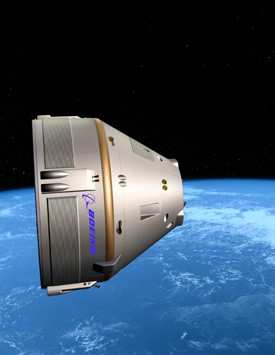Tue, Apr 24, 2012
Initial Commercial Space Transportation Flight Ops To Be Coordinated With Johnson Space Center
An agreement has been signed between NASA's Mission Operations Directorate (MOD) at Johnson Space Center and Boeing to collaborate on mission planning, training and flight operations for the company’s Commercial Space Transportation (CST)-100 spacecraft. Under the new arrangement, which Boeing negotiated under its current Phase 2 NASA Space Act Agreement for Commercial Crew Development, Boeing will begin discussions with the MOD on integrating launch operations and the company's own mission control facility at Kennedy Space Center, FL, with training and real-time operations at Johnson Space Center in Houston.

"Adding MOD to our team leverages NASA's experience in crewed space operations to ensure mission success for our CST-100 spacecraft," said Chris Ferguson, director of Crew and Mission Operations for the Boeing Commercial Crew Program. "As we continue to mature our spacecraft design, MOD technical support will ensure the CST-100 is built with the operators in mind."
Later this year, Boeing intends to enter into a larger agreement with the MOD to provide end-to-end flight operations from the command and control facility in the Mission Control Center at Johnson Space Center, the site where NASA managed the Apollo missions and all 135 flights of the space shuttle. "Colocating initial CST-100 flight operations with the International Space Station flight control facility in the Mission Control Center will facilitate a seamless transition to regularly scheduled CST-100 operations with the space station," Ferguson said. "Working with MOD on Boeing's mission operations also will help NASA retain key proficiencies for future human spaceflight operations."
The CST-100 is a reusable capsule-shaped spacecraft based on flight-proven subsystems and mature technologies. The system can transport up to seven people, or a combination of people and cargo. Boeing has designed the spacecraft to be compatible with a variety of expendable rockets to enable competition and reduce cost over the program life cycle. The company has selected United Launch Alliance's Atlas V launch vehicle for initial test flights that will begin as early as 2015.
Boeing is continuing to develop the system design at its Houston and Huntington Beach, Calif., sites and is making preparations to manufacture, assemble and test the CST-100 spacecraft in the former Orbiter Processing Facility-3 at Kennedy Space Center. (Image provided by Boeing)
More News
Aero Linx: Transport Canada We are a federal institution, leading the Transport Canada portfolio and working with our partners. Transport Canada is responsible for transportation p>[...]
Gross Navigation Error (GNE) A lateral deviation from a cleared track, normally in excess of 25 Nautical Miles (NM). More stringent standards (for example, 10NM in some parts of th>[...]
From AirVenture 2017 (YouTube Edition): Flight-Proven Booster On Display At AirVenture… EAA AirVenture Oshkosh is known primarily as a celebration of experimental and amateu>[...]
Aircraft Parachute System (CAPS) Was Deployed About 293 Ft Above Ground Level, Which Was Too Low To Allow For Full Deployment Of The Parachute System Analysis: The day before the a>[...]
Also: 48th Annual Air Race Classic, Hot Air Balloon Fire, FAA v Banning 100LL, Complete Remote Pilot The news Piper PA-18 Super Cub owners have been waiting for has finally arrived>[...]
 ANN's Daily Aero-Linx (06.29.25)
ANN's Daily Aero-Linx (06.29.25) ANN's Daily Aero-Term (06.29.25): Gross Navigation Error (GNE)
ANN's Daily Aero-Term (06.29.25): Gross Navigation Error (GNE) Classic Aero-TV: Anticipating Futurespace - Blue Origin Visits Airventure 2017
Classic Aero-TV: Anticipating Futurespace - Blue Origin Visits Airventure 2017 NTSB Final Report: Cirrus SR22
NTSB Final Report: Cirrus SR22 Airborne Affordable Flyers 06.26.25: PA18 Upgrades, Delta Force, Rhinebeck
Airborne Affordable Flyers 06.26.25: PA18 Upgrades, Delta Force, Rhinebeck



